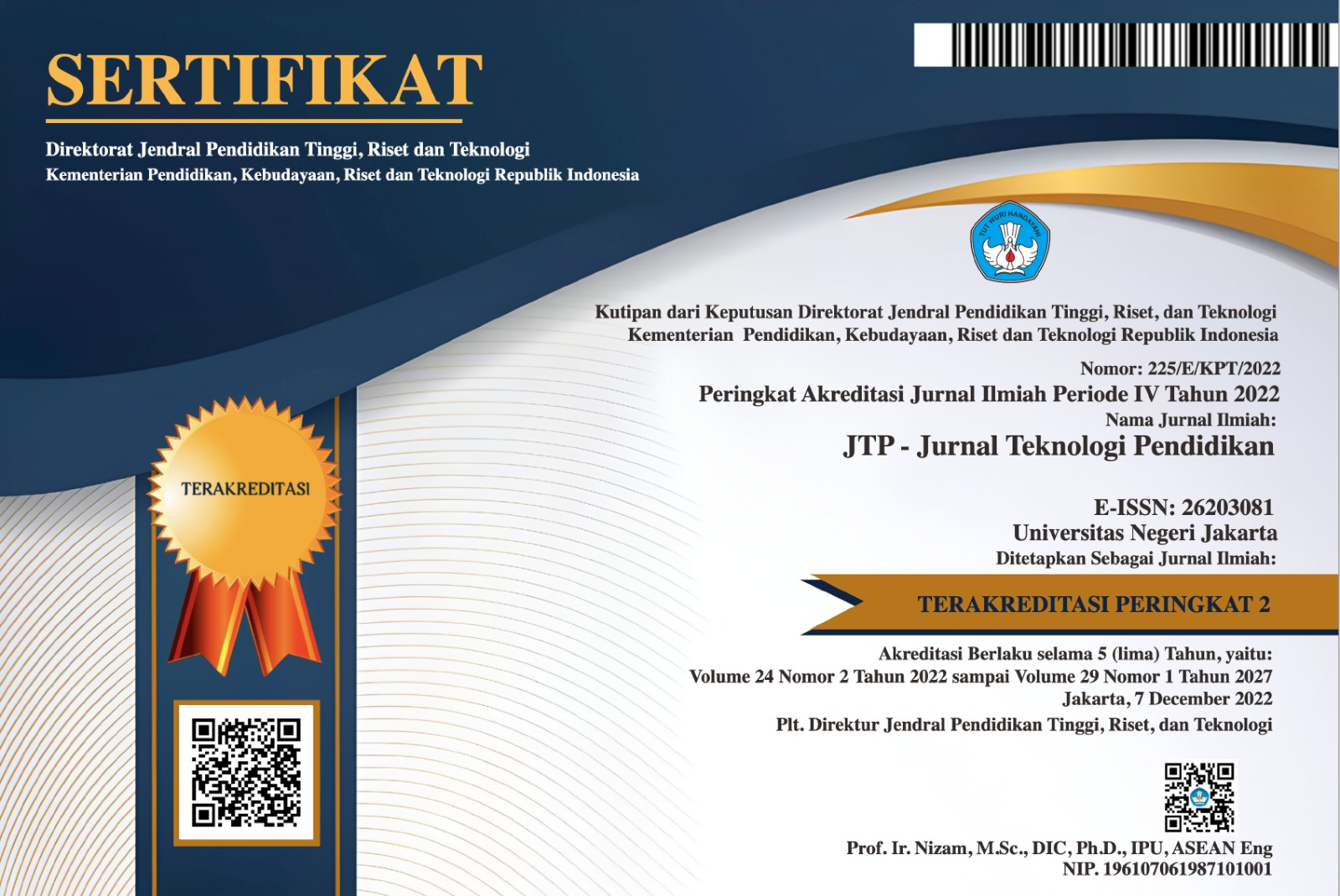Blended Learning and Critical Thinking in Acrylic Removable Partial Denture Theory Course
DOI:
https://doi.org/10.21009/jtp.v26i3.45247Keywords:
Leraning model, critical thinking, study results of theoretical acrylic removable partial denturesAbstract
This study aimed to examine the influence of blended learning model and critical thinking on students’ learning outcomes in acrylic removable partial denture theory course. The research was preceded by designing a blended lesson on acrylic removable partial denture theory course using the ASSURE learning model by considering objective conditions in the Department of Dental Engineering, Health Polytechnic, Ministry of Health, Jakarta II. Experiment was used as the research method with 2x2 treatment by level design. The data analysis was carried out using two- way analysis of covariance (ANCOVA). The results of the research found that students’ learning outcomes in the blended learning acrylic removable partial denture theory course were generally better than face-to-face learning, especially in the group of students with high critical thinking. The group of students with low critical thinking did not produce significantly different results.
References
Adarkwah, M. A., & Huang, R. (2023). Blended learning for the “multi-track” undergraduate students in Ghana in an adverse era. Scientific African.
Adarkwah, M. A., & Huang, R. (2013). Scientific African.(2023). Jurnal Teknologi Pendidikan, 101-106.
Alan, S., & Yurt, E. (2024). Flipped Learning: An Innovative Model for Enhancing Education Through ChatGPT. International Journal of Modern Education Studies, 8(1), 124–148.
Aljawfi, A. M., Hassanen, R. H., & Sharkawy, S. A. (2023). Effectiveness of training program by blended learning on knowledge and practices regarding first aid among preparatory year engineering students at Assiut University. Journal of Public Health and Development.
Batır, Z., & Özlem Sadi. (2021). A Science Module Designed Based on The Assure Model : Assure Modeline Dayali Bir Fen Modülü Önerisi : Potansiyel Enerji. Journal of Inquiry Based Activities (JIBA), 11(2), 111–124.
Dabbagh, N. (2004). Online Learning: Concepts, Strategies and Application. New Jersey: Pearson.
Darling-Hammond, L., Flook, L., Cook-Harvey, C., Barron, B., & Osher, D. (2020). Implications for educational practice of the science of learning and development. Applied Developmental Science, 24(2), 97–140. https://doi.org/10.1080/10888691.2018.1537791.
Elisanti, E., Sajidan, S., & Prayitno, B. A. (2018). The Profile of Critical Thinking Skill Students in XI Grade of Senior High School. International Conference on Science, Mathematics, and Education, 218(ICoMSE 2017), 205–209. https://doi.org/10.2991/icomse-17.2018.36.
Eugenia, M. W. (2009). Comparative Blended Learning Practices and Environments. New York: Information Science Reference.
Giantari, I. G. A. K., Sukawat, T. G. R., Yasa, N. N. K., & Setini, M. (2022). Learning Process in Improving the Quality of Learning in Education Environment. Quality - Access to Success, 23(187), 32–38. https://doi.org/10.47750/QAS/23.187.04
Hastuti, I. D., Surahmat, & Sutarto. (2020). Interaction pattern of inquiry learning on data collection and presentation material at SDN 13 ampenan. Universal Journal of Educational Research, 8(3), 942–947. https://doi.org/10.13189/ujer.2020.080328
Liana, D. N., Setiawan, I., Ihsan, M. K., R, S. A., Wibisono, S., Putra, A., Darmanto, J., & Supomo, H. (2024). The Implementation of The Assure Model To Develop A Learning Design For Technical Drawing Skills Among Vocational Students. Journal of Mechanical Enginering and Vocational Education, 7(1), 1–5.
Mahmud, R., Syahrul, & Mangesa, R. T. (2021). Interaction patterns and blended learning activities using the Moodle platform during a pandemic in vocational high school. AIP Conference Proceedings: Proceedings of the 6th Progressive and Fun Education International Conference, 2438(October). https://doi.org/10.1063/5.0071355
Munna, A. S., & Kalam, M. A. (2021). Teaching and Learning Process to Enhance Teaching Effectiveness: Literature Review. International Journal of Humanities and Innovation (IJHI), 4(1), 1–4. https://doi.org/10.33750/ijhi.v4i1.102.
Paristiowati, M. (2015). Pengaruh Model Pembelajaran dan Kemampuan Berpikir Kritis Mahasiswa Terhadap Hasil Belajar KImia Fisika II. Jakarta: Universitas Negeri Jakarta.
Sami, H. K. A.-K., Raheemah, R. H., & Ali, R. M. (2019). An ASSURE-Model Instructional Design Based on Active Learning Strategies and Its Effect for 1st Intermediate Student’s Higher Order Thinking Skills in Teaching Science text book. Psihologija, 52(5), 339–349. https://www.researchgate.net/publication/338955686_An_ASSURE-Model_Instructional_Design_Based_on_Active_Learning_Strategies_and_Its_Effect_for_1st_Intermediate_Student%27s_Higher_Order_Thinking_Skills_in_Teaching_Science_text_book
Sari, I. N. (2023). Effectiveness of Implementing Synchronous and Asynchronous Blended E-Learning in Stunting Prevention and Treatment Training Programs. JTP - Jurnal Teknologi Pendidikan, 25(1), 101–106. https://doi.org/10.21009/jtp.v25i1.34951
Simamora, A. B., Widodo, W., & Sanjaya, I. G. M. (2020). Innovative Learning Model: Improving The Students’ Scientific Literacy Of Junior High School. IJORER : International Journal of Recent Educational Research, 1(3), 271–285. https://doi.org/10.46245/ijorer.v1i3.55
Smaldino, S. E., Lowther, D. L., & Mims, C. (2018). Instructional Technology and Media for Learning. New Jersey: Pearson.
Sudirman, Ridwan. (2023). The Effectiveness of Blended LearningModel on Students’ PsychomotorSkills in Pencak Silat.. Jurnal Tdeknologi Pendidikan, 131-139.
Supriyadi, et al. (2023). The Effectiveness of STEM-Integrated Blended Learning on Indonesia Student Scientific Literacy: A Meta-analysis. International Journal of Education and Literature. 2. (1)
Suryono et al. The Effect of the Blended Learning Model on Student Critical Thinking Skill: Meta-analysis. Edumaspul: Jurnal Pendidikan. 2023. 7 (1).
Downloads
Published
How to Cite
Issue
Section
License
Copyright (c) 2024 Fitriyanti Fitriyanti, Didik Marsigid, Sri Wiwik Wiyanti

This work is licensed under a Creative Commons Attribution-ShareAlike 4.0 International License.
Jurnal Teknologi Pendidikan is an Open Access Journal. The authors who publish the manuscript in Jurnal Teknologi Pendidikan agree to the following terms.
Attribution-ShareAlike 4.0 International (CC BY-SA 4.0)
-
Attribution — You must give appropriate credit, provide a link to the license, and indicate if changes were made. You may do so in any reasonable manner, but not in any way that suggests the licensor endorses you or your use.
-
ShareAlike — If you remix, transform, or build upon the material, you must distribute your contributions under the same license as the original.
- No additional restrictions — You may not apply legal terms or technological measures that legally restrict others from doing anything the license permits.
Notices:
- You do not have to comply with the license for elements of the material in the public domain or where your use is permitted by an applicable exception or limitation.
- No warranties are given. The license may not give you all of the permissions necessary for your intended use. For example, other rights such as publicity, privacy, or moral rights may limit how you use the material.







